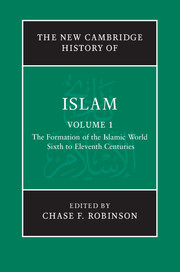Book contents
- Frontmatter
- Introduction
- PART I THE LATE ANTIQUE CONTEXT
- PART II UNIVERSALISM AND IMPERIALISM
- PART III REGIONALISM
- 10 Arabia
- 11 The Islamic east
- 12 Syria
- 13 Egypt
- 14 The Iberian Peninsula and North Africa
- PART IV THE HISTORIOGRAPHY OF EARLY ISLAMIC HISTORY
- Conclusion: From formative Islam to classical Islam
- Glossary
- Bibliography
- Index
- Plate Section
- References
11 - The Islamic east
from PART III - REGIONALISM
Published online by Cambridge University Press: 28 March 2011
- Frontmatter
- Introduction
- PART I THE LATE ANTIQUE CONTEXT
- PART II UNIVERSALISM AND IMPERIALISM
- PART III REGIONALISM
- 10 Arabia
- 11 The Islamic east
- 12 Syria
- 13 Egypt
- 14 The Iberian Peninsula and North Africa
- PART IV THE HISTORIOGRAPHY OF EARLY ISLAMIC HISTORY
- Conclusion: From formative Islam to classical Islam
- Glossary
- Bibliography
- Index
- Plate Section
- References
Summary
The concepts of both the ‘Islamic east’ and ‘regionalism’ are nebulous enough to require some definition for the purposes of this discussion. In the case of the ‘Islamic east’ there are two terms sometimes found in Muslim geographical and historical works that could be understood as referring to such an area: al-sharq and al-mashriq. Al-sharq, the east in general, should probably be understood, at least in the conceptual framework of most medieval Muslim geographers, as referring to everything to the east of Egypt. Al-mashriq, the eastern lands, refers to a smaller and more distinct component of this territory; as a term, it was certainly in usage by 203/818f., as it appears on a coin of that date. It was precisely defined by the geographer al-Muqaddasī (d. c. 380/990) as encompassing Khurāsān, Sīstān (Sijistān) and Transoxania (Mā Warāʿ al-Nahr), an area which he saw as a unity but which his predecessor, Abū Zayd al-Balkhī (d. 322/934) had regarded as a group of regions (aqālīm). Neither of these concepts is well suited for the present purpose: al-sharq is much too broad, as it would include areas such as Syria, while al-mashriq is perhaps too narrow, as it would exclude Ṭabaristān and other areas.
Keywords
- Type
- Chapter
- Information
- The New Cambridge History of Islam , pp. 448 - 505Publisher: Cambridge University PressPrint publication year: 2010
References
- 1
- Cited by



